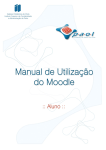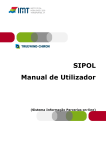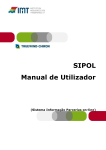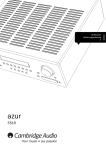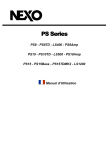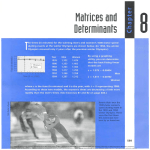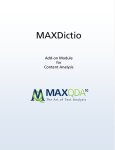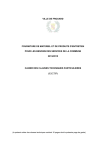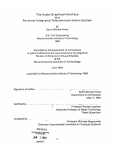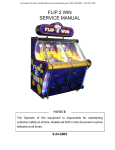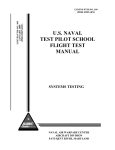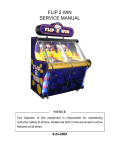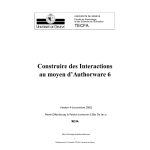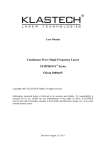Download Deliverable Template IMAT
Transcript
IMAT (ESPRIT 29175) Integrating Manuals and Training Scenarios and guidelines, version 2 Author(s): Yvonne Barnard TNOHF Suzanne Kabel TNOFEL Johan Riemersma TNOHF Cyrille Desmoulins LORIA Monique Grandbastien Work package: IV Common Services Deliverable Type: R Deliverable Number: R.IV.2 Responsible org.: TNO Availability: P Contractual Date: 151100 Actual Date: 271100 Version: Final Pages: 48 Author email: [email protected] Copyright © 1999 The IMAT Consortium Abstract: LORIA ESPRIT 29175 IMAT R.IV.2 Scenarios and guidelines, version 2 In this document we define the ways in which the IMAT scenario’s for maintenance training can be used effectively to develop training material. A maintenance training vocabulary provides the building stones for a scenario, while a scenario is a prototypical framework for training material. The evaluation of the previous prototype tools resulted in the tools described here to support the user in creating training material. Keyword List: Version 2 scenarios, maintenance training ontology, scenario tool, evaluation Page 2 of 48 ESPRIT 29175 IMAT 1 R.IV.2 Scenarios and guidelines, version 2 Table of Contents 1 TABLE OF CONTENTS...........................................................................................3 2VERSION CONTROL................................................................................................5 3EXECUTIVE SUMMARY ..........................................................................................6 4INTRODUCTION.......................................................................................................7 5PURPOSE OF SCENARIO DEVELOPMENT...........................................................8 6STAKEHOLDERS.....................................................................................................9 7 INSTRUCTIONAL MATERIAL TO BE CREATED WITH IMAT.............................11 8HIGH LEVEL SCENARIOS.....................................................................................12 9DEVELOPMENT OF INSTRUCTIONAL MATERIAL..............................................16 9.1Learning goal....................................................................................................................................16 9.2Knowledge type...............................................................................................................................17 9.3Instructional strategy......................................................................................................................18 9.4Instructional activities.....................................................................................................................19 9.5Instructor actions and Learner actions.........................................................................................20 9.6Material use......................................................................................................................................23 9.7Fragment description types ...........................................................................................................24 9.8Instructional scenarios....................................................................................................................24 10 SEARCHING FOR FRAGMENTS IN THE DATABASE AND INSTRUCTIONAL MARKUP..................................................................................................................29 11 SCENARIO TOOL ..............................................................................................31 11.1 Use of the Scenario Tool in the IMAT process..........................................................................31 11.2 General tool description. ..........................................................................................................32 11.3 User interface requirements........................................................................................................32 11.4 Tool implementation.....................................................................................................................32 Version 2 Page 3 of 48 ESPRIT 29175 IMAT R.IV.2 Scenarios and guidelines, version 2 12 EVALUATION.......................................................................................................33 12.1Tools evaluation.............................................................................................................................33 12.1.1Setup........................................................................................................................................33 12.1.2Results......................................................................................................................................33 12.2 User requirements........................................................................................................................35 12.2.1Updated requirements from the users......................................................................................35 12.2.2General user requirements.......................................................................................................35 12.2.3Further evaluation.....................................................................................................................39 13 BIBLIOGRAPHY AND REFERENCES................................................................40 14 APPENDIX A: P1 AEI&I TOOL EVALUATION FORM........................................41 Version 2 Page 4 of 48 ESPRIT 29175 IMAT R.IV.2 Scenarios and guidelines, version 2 2 Version Control Version no. 2.0 2.4 2.5 2.6 Final Version 2 Date Resp. Changes to previous versions 13900 91100 141100 221100 271100 TNO TNO TNO TNO TNO Creation of document. Update and extension of document Sent out to partners for comments Minor changes after discussion with CNRS Final after comments from the partners Page 5 of 48 ESPRIT 29175 IMAT R.IV.2 Scenarios and guidelines, version 2 3 Executive Summary In this document we define the ways in which the IMAT scenario’s for maintenance training can be used effectively to develop training material. A maintenance training vocabulary provides the building stones for a scenario, while a scenario is a prototypical framework for training material. The evaluation of the previous prototype tools resulted in the tools described here to support the user in creating training material. In the organisations addressed by IMAT, dealing with training, production of training material, maintenance tasks, operation of complex technical equipment, and technical manuals, three main categories of stakeholders can be distinguished: learners, instructors, and developers of instructional material. Scenarios are developed and used as follows: 1. A high level scenario is determined. This is an organisational choice. Six high level scenarios are predefined, describing the use of manuals for the creation of instructional material and in training, specifying the type of training and the formality of training. 2. Depending on the high level scenario, the instructional design for maintenance training is further specified: - a learning goal is set, specifying what to teach, - a knowledge type is chosen, specifying what kind of knowledge the learner should gain, - an instructional strategy is chosen, specifying how to teach, - instructional activities are chosen, specifying what actions the instructor and the learner should take in the training process, - instructional activities are refined into instructor and learner actions, specifying individual actions, as well as material use (the way the material from the technical manual is going to be used in the training material), - the instructional scenario is filled in, specifying a standard lesson template including what kind of fragments (fragments with a certain description type, specifying from which perspective the fragment was written) should be retrieved from the database. The user can use prespecified tables of learning goals, knowledge types, instructional strategies and instructional activities, and instructional scenarios with a mapping to fragment description type. In these tables, it is indicated which combinations of goals, knowledge types, strategies, activities, actions and fragment description types are appropriate. 3. Fragments from the technical manual are automatically indexed on high level description types. The user can additionally index fragments on knowledge type and material use. The user can import the fragments in an authoring environment. Evaluation is an important part of the IMAT work. The users, RNLAF, AFPA and ETRA, worked with the first IMAT prototype tools, from these experiences, user requirements evolved which will have to be met by the second version of the IMAT tool. IMAT can support the user organizations with new ways of producing training material, producing new kinds of training material and provide new ways of organizing training. Version 2 Page 6 of 48 ESPRIT 29175 IMAT R.IV.2 Scenarios and guidelines, version 2 4 Introduction In this document we define the ways in which the IMAT scenario’s for maintenance training can be used effectively to develop training material. A maintenance training vocabulary provides the building stones for a scenario, while a scenario is a prototypical framework for training material. The evaluation of the previous prototype tools resulted in the tools described here to support the user in creating training material. As the IMAT tools1 are under development, it is difficult to envisage all kinds of possibilities they offer to users. There is also outside the IMAT project and the associated work of its partners little actual experience with the use of electronic manuals in training (Barnard et al., 1998; Jorgensen et al., 1995; Kribs et al., 1996; Morris & Dickason, 1996). Although we see a great diversity of opportunities for the outcomes of the project, we will have to limit ourselves in the creation of scenarios of use, in order to ensure that we come up with practical (but innovative) solutions. Scenarios should take into account the shortterm and the longterm possibilities to incorporate technical manuals in training. Most shortterm scenarios will be instructor based, in the longterm justintime, distributed and webbased training scenarios will become feasible. We have to take care that our (potential) users will be able to recognise the benefits for their training in the current situation while on the other hand giving them a perspective on new ways of training. This document is part of the IMAT P2 work. It describes instructional ontologies (maintenance training vocabularies), how to create a scenario, how to use the scenario tool, and the results of the P1 evaluation. For an extensive description of the instructional ontologies and a definition of the terms used, we refer to deliverable O2b, Second Didactic Ontology. The structure of this document is as follows: - Purpose of scenario development - Stakeholders in the scenarios - Instructional material to be created with IMAT - High level scenarios - Development of instructional material - Instructional markup - The scenario tool The IMAT tools consist of a Document Analysis tool; an Indexing and Retrieval tool; and a Scenario tool. The Document Analysis tool enables the user to separate and index a technical manual and to store fragments in a database. The Indexing and Retrieval tool enables the user to search for fragments and to index them with instructional information. The Scenario tool enables the user to specify an instructional scenario (standard lesson), in order to pick the right fragments from the database. 1 Version 2 Page 7 of 48 ESPRIT 29175 IMAT R.IV.2 Scenarios and guidelines, version 2 5 Purpose of scenario development Scenarios describe the way in which the IMAT tools can be used to produce instructional material from a technical manual. The purpose of providing IMAT users with scenarios is to support them in the development of instructional material and in the organisation of the training process. There are several reasons for providing support in the form of scenarios: - To provide on the one hand standard ways of creating instructional material and organising training in order to make this process more efficient, while on the other hand allowing for customisation according to the specific needs of a user - To provide standard good practice ways of training, especially for those instructors and developers of instructional material who are inexperienced or who have little background in educational science - To show instructors and developers of instructional material how to set up new, innovative ways of training - To work towards further industrialising the process of training development in technical domains In order to fulfil these support roles, we have to define scenarios in a standardised format, giving users ample opportunity for customisation. We have to take into account scenarios which are directly related to the current practices of the user organisations in IMAT. These scenarios can be derived from the training requirements documents generated in workpackage I, II and III. New, innovative scenarios have to be derived from the expertise of the partners in the area of educational science and from exploring the possibilities offered by the IMAT tools. We distinguish three levels of scenario descriptions: 1. General, free text descriptions of highlevel scenarios for the use of manuals for the creation of instructional material and in training. 2. Instructional scenarios consisting of specific frameworks or building blocks to support the developer of training material and the user of instructional material. These building blocks specify what kind of fragments the developer should look for and how to use these fragments in the further authoring and training process. These building blocks can be combined into more complex scenarios. 3. Instructional markup, to be attached to fragments of the technical manual in order to specify the kind of knowledge and instructional use of the fragments. Version 2 Page 8 of 48 ESPRIT 29175 IMAT R.IV.2 Scenarios and guidelines, version 2 6 Stakeholders In the organisations addressed by IMAT, dealing with training, production of training material, maintenance tasks, operation of complex technical equipment, and technical manuals, many stakeholders can be distinguished. Stakeholders are learners, instructors, developers of training, training material, manuals, manufacturers of equipment, managers, training managers, operators and maintainers of equipment, logistics personnel, and probably many more. In the IMAT scenarios we will restrict ourselves to three main categories of stakeholders: learners, instructors, and developers of instructional material. The restriction is not made because we do not see the importance of the other stakeholders, but because the focus of the IMAT project is on the reuse of technical material for training purposes. These three categories are the direct users involved in this process and the IMAT tools offer them support. The stakeholders in focus are: 1. Learners Prototypical IMAT learners are: • Employees of a company who are trained in order to learn new tasks, or to update their knowledge and skills, working in a technical domain such as maintenance and repair of complex technical systems • Learners who are trained in a training centre (inhouse or a public centre) to qualify for a technical profession in maintenance or repair • Experienced employees of a company, working as maintenance and repair engineers, who have to perform tasks in which they are not proficient so they need onthejob and justintime training 2. Instructors Prototypical IMAT instructors are: • Technical engineers with ample domain expertise and experience in performing technical tasks who have a limited didactic background • Teachers with a background in education, who have limited theoretical experience in the domain, often lacking practical experience 3. Developers of instructional material Prototypical IMAT developers of instructional material are: • Specialised developers at training centres who have as their main job the development of (multimedia) instructional material • Instructors who have as their main job to provide training but who develop their own material; they have no special expertise in development • Instructors who adapt and augment standard training material, probably coming from a training centre, to fulfil their own needs. 4. Training managers The training manager takes care of the management of training material, performing such tasks as determining who is authorised to make changes in the material, taking care of the database etc. In the P2 tools, several options are builtin for updating material and authorizing access. Version 2 Page 9 of 48 ESPRIT 29175 IMAT R.IV.2 Scenarios and guidelines, version 2 NB. The stakeholders are described in terms of roles; it is possible for an actual person to fulfil more than one role. Version 2 Page 10 of 48 ESPRIT 29175 IMAT 7 R.IV.2 Scenarios and guidelines, version 2 Instructional material to be created with IMAT From the IMAT fragments, different kinds of instructional material can be created. The format and medium differ (paper document, electronic slides, CBT, etc) as well as the authoring tools with which the instructional material is constructed (Word, PowerPoint, Authorware, Toolbook). There are five kinds of relation between the technical manual and the instructional material: 1. Separate instructional material is created by using the fragments from the technical manual. The instructional material is separated from the manual and can be used stand alone. For example a syllabus or a CBT. 2. A set of instructional fragments is created from the database of fragments from the technical manual. The fragments are selected from the technical manual on the basis of predefined lesson structures (lesson scenarios). The lesson structure and the selected fragments can be stored. The specific, actual lesson material can then be created by using the fragments, and further elaborating and adapting the standard lesson structure. 3. Instructional material is created with a direct link to the electronic technical manual. In this case the instructional material can only be used in combination with the electronic manual. From the instructional material dynamic links are made with the manual, for example a PowerPoint slide with hotspots which are linked to the relevant section in the manual. 4. The instructional material is a didactic layer on the electronic manual. In this case the manual is enriched for training purposes with notes, advice, assignments, more elaborate explanations etc. 5. Another situation is feasible in which there is no real instructional material, but the learner can search the manual for relevant information using the IMAT tools, if necessary enhanced with a learner oriented interface. The learner can use it to do assignments which ask for information from the technical manual or to learn how to use the manual. The IMATproject is concentrated on the first two kinds of instructional material. This is also due to the current training needs of the user partners. Options 3 and 4 are closely connected with the technical manual as it is delivered for maintenance purposes (see Barnard et al 1998 for an elaboration of these options).. IMAT did not take these options into account. Option 5 is out of scope for IMAT at the moment, but it is worthwhile to keep in mind for future use of the tools. Version 2 Page 11 of 48 - ESPRIT 29175 IMAT R.IV.2 Scenarios and guidelines, version 2 8 High level scenarios At an organisational level, a high level scenario is often already present, like the situation in which an instructor develops his/her own material and uses it for initial training As organisations change, an organisation can decide to adapt its current high level scenario to that change.. The dimensions and factors that play a role in the origination and change of a high level scenario are described in this section (Note that the decision for a high level scenario is not supported by the Scenario Tool.) Of all possible dimensions one can use to develop scenario types, the next two seem the most versatile ones: Type of training: Initial/general training for the first qualification as maintenance engineer - Qualification training for a certain type of equipment Training for performing special tasks by already qualified personnel Scale and formality of training: - Centralised development of training materials by specialist developers On location development of training material by instructors Justintime use of documentation to train for specialised tasks crossing these two dimensions, one gets six scenarios: Centralised On location Justintime Initial/general 1 2 System type qualification 3 4 Special tasks 5 6 Table 1 Type of training crossed by Scale and formality of training To further elaborate, for each scenario some of the roles and functions have been filled in. This results in: Scenario: Developers Instructors Peers 1 Develop/Produce Teach Collaborate 2 Develop /Produce Collaborate 3 Develop/Produce Produce Collaborate 4 Develop /Produce Collaborate 5 Coach/collaborate Collaborate 6 Collaborate Table 2 Roles and functions for scenarios The scenarios can be described as follows: Scenario 1: Development by developer of instructional material, for initial/general training In this scenario a specialised developer develops the instructional material. The material is used by the instructor. In scenario 1 in general only generic knowledge and skills will be acquired. Use of specific systems and documentation can serve as ‘illustrative examples’ in Version 2 Page 12 of 48 ESPRIT 29175 IMAT R.IV.2 Scenarios and guidelines, version 2 the process directed at acquiring more general knowledge about technical concepts, principles, generic maintenance tasks and skills and the use of documentation in general. Insofar material is drawn from electronic technical documentation, this will be a subset of the use in scenario’s 3 and 4. It is also possible to develop computer based training material which can be used by the learners directly, for example using fragments from the technical manual as content in an Authorware or Toolbook program. Scenario 2: Development by instructor, for initial/general training This scenario resembles scenario 1, only in this scenario the instructional material is developed by the instructor who directly uses the material. In scenario’s 2 in general only generic knowledge and skills will be acquired. Use of specific systems and documentation can serve as ‘illustrative examples’ in the process directed at acquiring more general knowledge about technical concepts, principles, generic maintenance tasks and skills and the use of documentation in general. Insofar material is drawn from electronic technical documentation, this will be a subset of the use in scenario’s 3 and 4. By decentralized, direct development by the instructor, the instructor is able to customize the material to the specific class he/she is teaching. A combination between scenario 1 and 2 is possible, centralized development of the basic material and further adaptation by the instructor locally. Scenario 3: Development at a centre, for qualification training In this scenario a developer at a centre develops instructional material, to be used by the learners directly, by teachers at the centre itself or on location by instructors. The material can be paperbased for direct use by the learners and/or in the form of a prepared presentation. A developer of instructional material develops paperbased material about a certain piece of equipment and its components for direct use by the learners. In this situation, the developer copies pictures or texts from the database to a presentation program such as Microsoft PowerPoint. The developer searches with the IMAT tools for a general description of a component, a description of its function, a picture with the location of the component and a picture of the electronic scheme of the component. The developer can add more information to the fragments found in the database. The transparencies can be augmented by remarks or explanations, parts can be coloured etc. By using programs like PowerPoint, it is also possible to make presentations that are more dynamic. For example, an image of the fuel tank can be build up by letting the different components appear one by one. Or the fuel stream can be shown by letting a coloured stream go through the different pipes. Hereto the developer selects from the database drawings and photos, which show the component to be treated. If the material is finalised, it is printed out and given to the learners. It is also possible to create computer based training programs, for example by using authoring languages like Authroware and Toolbook, using fragments from the technical manual as content. In the second option a developer of instructional material prepares material to be further customised by a instructor or learner. The instructional material is then constructed in two phases: first the developer selects material from the database and next it is customised by the instructor who is responsible for the lessons. This scenario is suitable for a centralised training institute where specialised people (either domain specialists or educational experts) take care of the production of instructional material. For example standardised PowerPoint presentations are created. This material is given to the instructors, maybe in a training centre, who have the freedom to customise the material. This can be done by further adding features to the presentation, by adding personal comments etc. It is also possible that the learners have the possibility to change the material, for example when they use electronic syllabi or workbooks. They can change the material by adding their own annotations, fill in answers to questions, or do assignments etc. Version 2 Page 13 of 48 ESPRIT 29175 IMAT R.IV.2 Scenarios and guidelines, version 2 For large groups of trainees, the selected and modified material can be embedded in a CBT package or CBT programs can be developed which use the technical manual as a source of domain knowledge by means of dynamic links. This means great savings in development cost. Challenge is to provide for options to retain the integrity of links in the course of time, when many small changes in the technical manual itself are made. Scenario 4: Development on location, for system qualification training The instructor prepares a presentation about a component in the equipment. In this situation, the instructor copies pictures or texts from the database to a presentation program such as Microsoft PowerPoint. The instructor searches with the IMAT tools for a general description of a component, a description of its function, a picture with the location of the component and a picture of the electronic scheme of the component. The instructor can add more information to the fragments and augment them by adding remarks or explanations, colouring of parts or connections, or making them more dynamic, etc. In this way, the instructors can make a presentation, which is tailored to their own ideas. They can easily make changes if it turns out that some pictures or texts are not clear for trainees. The transparencies can be arranged in a certain order and the presentation is ready to be used in the classroom. It is also possible to store personal annotations of the instructor with the PowerPoint presentations. In this way, the instructors can have their own electronic annotated presentations; this is also very handy if a second instructor has to take over the lessons. Scenario 5: Special and complex tasks For special and/or complex tasks a form of on the job training seems most optimal. In this scenario, instructors can prepare assignments on the level of tasks, which are based on cases. The trainees have to find information about components, the right procedures to diagnose a fault and to fix the identified faulty component. The assignments can be enriched with annotations by the instructor in the form of hints, guidelines, reminders and so on. In this way training material can be presented to trainees for training on the job in their own time and pace. When in some way the learners results are being kept track of, further cases can be suggested, which are tuned to diagnosed weaknesses of the learner. Implementation can be in the form of an electronic assistant. Another possibility is to present cases as assignments without enrichment. The instructor has then the role of coach or even collaborator. Coaching takes the form of helping and guiding the trainee in doing the job. Scenario 6: Justintime preparing for special and complex tasks In this scenario, no specific instructional material is developed. However, in the course of time, experiences with different types of tasks can be stored in organisational memories for later use as examples of solutions for comparable problems as the one at hand. Prior to doing special or complex tasks, the engineer can prepare by studying the technical manual. He/she has to select (using the IMAT tools) and study all relevant information concerning the components involved, the procedure described, the relevant safety regulations and the tools to be used. It depends on the level of sophistication of the technical manual how much guidance and explanations have been added to it in the form of jobaids, expert systems etc., and thus whether all required information and guidance can easily be found. In nonstandard or not foreseen problem situations, the engineer has to fall back on general knowledge and skills to devise the solution path him/herself or in collaboration with peers. A large repair job may be planned or simulated with the aid of a technical manual by a repair team of different specialists, discussing the different options and learning about possible ways to proceed. In the ideal situation it may also be possible to make specific queries to organisational memories, thereby profiting from earlier experiences of other engineers, confronted with the same or comparable problems. These experiences Version 2 Page 14 of 48 ESPRIT 29175 IMAT R.IV.2 Scenarios and guidelines, version 2 can be laid down in formal or more informal ways, the latter for instance in the form of personal notes. Version 2 Page 15 of 48 ESPRIT 29175 IMAT R.IV.2 Scenarios and guidelines, version 2 9 Development of instructional material In this section we concentrate ourselves on the development of instructional material. The high level scenarios provide a description of the ways in which instructional material can be produced from fragments of the technical manual. The instructional material produced in the high level scenarios can be described in a more formal and detailed way, using the maintenance training ontology (for an extensive description of the instructional ontologies and a definition of the terms used, we refer to deliverable O2b, Second Didactic Ontology). It contains the following top level concepts: - Learning goal - Knowledge type - Instructional strategy - Instructional activity - Instructor and learner action - Fragment description type These concepts are similar to the steps a developer of instructional material has to take in Instructional Design methods (Gagné, Briggs, & Wager, 1992) and which are supported by instructional design tools such as Designer’ s Edge (See reference). The complete ontology is described in the next subsections. To come from a given high level scenario to instructional material the following actions have to be taken: - Set a learning goal, - Determine the knowledge type, - Choose an instructional strategy, - Determine instructional activities, - Define accompanying instructor and learner actions, - Select useful fragments from the database and transfer them to an authoring tool. The instructional ontology or maintenance training ontology supports the actions that have to be taken to come from a high level scenario to instructional material by defining concepts and mapping them onto each other. Products are syllabi, presentations or CBT. 9.1 Learning goal A learning goal describes the desired outcome of an instructional curriculum in terms of knowledge, skills and attitudes that are necessary to carry out certain functions or tasks. In the kind of technical training we are dealing with in IMAT, most training is aimed at the following toplevel learning goals: - High level goal – being able to maintain system x - Being able to reason about system x - Structural knowledge of system x (hierarchical decomposition) - Functional knowledge of system x (hierarchical decomposition) - Being able to perform all maintenance tasks (within job) - To perform inspection task y (list y1…yn) Version 2 Page 16 of 48 ESPRIT 29175 IMAT - R.IV.2 Scenarios and guidelines, version 2 - Perceptual knowledge normal/deviant appearance - Declarative knowledge about safety/procedure/sequence/reporting - Skill in performing inspection - To perform preventive maintenance task z (list z1..zn) - Declarative knowledge about (preventive) maintenance - Declarative knowledge about safety/procedure/sequence/reporting - Skill in performing (preventive) maintenance - To perform corrective maintenance task z (list z1..zn) - Declarative knowledge about (corrective) maintenance - Declarative knowledge about safety/procedure/sequence/reporting - Skill in performing (corrective) maintenance Being able to do subsidiary tasks - Topical knowledge - Calibrate/maintain maintenance & diagnostic tools 9.2 Knowledge type Knowledge is information acquired and stored, in an organised manner, in the mind. Knowledge type stands for the knowledge that is necessary for a learner to appropriate in order to gain the learning goal. The following toplevel knowledge type concepts are identified: - Declarative Knowledge - Perceptual knowledge - Reasoning skills - Procedural knowledge - Performing skills - Attitudes Some learning goals go well together with some knowledge types. In Table 3, learning goal is mapped to knowledge type. Percep Declar Reaso Proced Perfor Attitude tual ative ning ural ming s knowle knowle skills knowle skills dge dge dge Being able to reason about system x Structural knowledge of system x (hierarchical decomposition) Functional knowledge of system x (hierarchical decomposition) X X X X X Being able to perform all maintenance tasks To perform inspection task y (list y1…yn) Perceptual knowledge normal/deviant appearance Declarative knowledge about safety/procedure/sequence/reporting Version 2 X X X Page 17 of 48 ESPRIT 29175 IMAT R.IV.2 Scenarios and guidelines, version 2 Percep Declar Reaso Proced Perfor Attitude tual ative ning ural ming s knowle knowle skills knowle skills dge dge dge Skill in performing inspection X X To perform preventive maintenance task z (list z1..zn) Declarative knowledge about (preventive) maintenance X Declarative knowledge about safety/procedure/sequence/reporting X X Skill in performing (preventive) maintenance X X To perform corrective maintenance tasks (list c1..cn) Declarative knowledge about (corrective) maintenance X Declarative knowledge about safety/procedure/sequence/reporting X Skill in performing (corrective) maintenance X X X X X X Being able to do subsidiary tasks (1,..n) Topical knowledge X Skill Table 3 Mapping table: Learning goal to Knowledge type 9.3 Instructional strategy Knowledge is communicated to the learner by means of instructional strategies. Instructional strategies refer to the effective way of teaching or to characteristics of an effective learning environment. The main instructional strategies (see in particular Chen, 1995) which can be distinguished in technical training are: − − − − − − Modelling Coaching Reflection Articulation Scaffolding and fading Exploration Some knowledge types go well together with some instructional strategies. A mapping is provided in Table 4. Version 2 Page 18 of 48 ESPRIT 29175 IMAT R.IV.2 Scenarios and guidelines, version 2 Articulatio Reflection Exploratio Modelling Coaching Scaffoldin n n g Perceptual knowledge X X Declarative knowledge X X Reasoning skills X X Procedural knowledge X X Performing skills Attitudes X X X X X X X Table 4 Knowledge type mapped to Instructional strategy 9.4 Instructional activities Instructional activities stand for the activities performed by instructor and learner. Instructional activities distinguished in maintenance training are: − − − − − − − − − − − − − − − − Setting goals Illustration Presentation Explanation Asking questions Providing workspace Instruction Demonstration Presenting tasks Providing examples Providing reminders Providing hints Evaluation Feedback Providing references Summarising Instructional strategies can be further detailed by crossing them with instructional activities. They are mapped to each other in Table 5. Version 2 Page 19 of 48 ESPRIT 29175 IMAT R.IV.2 Modelli ng Coachi ng Scaffol ding X X X Instruction X X Demonstration X Setting goals Articul ation Reflect ion X X Scenarios and guidelines, version 2 Illustration Explor ation X Presentation X X Explanation X X Asking questions X X Providing workspace X X Presenting tasks Providing examples X X X X X Providing reminders X Providing hints X Evaluation X X X X Feedback X X X X Providing references2 Summarising X X X X X X X X Table 5 Instructional strategies mapped to Instructional activities Once learning goal, knowledge type, instructional strategy and instructional activity are decided, a number of refinement steps and finally a mapping to the fragments is made. To be more precise: instructional activities are refined into individual instructor and learner actions, and learning goal and instructional activities are mapped to fragment description types. 9.5 Instructor actions and Learner actions Instructional activities are refined into instructor actions and learner actions. Instructor actions stand for everything the instructor does within a certain instructional activity, while learner actions stand for everything the learner does within a certain instructional activity. The following instructor actions are identified: - - Present - Learning goal - Illustration - Content - Summary Provide - Explanation - Workspace - Hints - Feedback - References References can be to a Glossary, Index, Lexicon, Bibliography, Annexes 2 Version 2 Page 20 of 48 ESPRIT 29175 IMAT - - - R.IV.2 Scenarios and guidelines, version 2 Construct - Questions Ask - Questions Explain - Next lessons Show - How a task is done Give - Instructions - Assignments - Example Evaluate - Own knowledge - Answer - Performance Diagnose - Lack of knowledge - Faults The following learner actions are identified: - - - - Comprehend - Learning goal - Question - Directions - Summary - Hints - Instructions - Assignments Accept - Learning goal Memorise (learnbyheart) - Content presented Memorise - Instructions - How a task is done Read - Explanation Listen to - Explanation Study - Explanation - Feedback - Illustration Relate - Explanation to existing knowledge Recall - Content Reason Answer - Question Version 2 Page 21 of 48 ESPRIT 29175 IMAT - R.IV.2 Scenarios and guidelines, version 2 Elaborate Apply - Hints Act on - Hints/references Observe - How a task is done Do - Assignments Instructional activity is refined in terms of the combined concepts in the instructor and learner actions in Table 6. Instructional Activity Setting goals Instructor and Learner Actions Instructor: Present the ‘current’ learning goal Learner: Illustration Instructor: Present illustration Learner: Presentation Comprehend instructions and memorise them Instructor: Show how a task has to be done Learner: Presenting tasks Use workspace Instructor: Give instructions Learner: Demonstration Comprehend question, Recall content or reason and answer question Instructor: Provide workspace Learner: Instruction Read, Listen to explanation; Study explanation; Relate explanation to existing knowledge Instructor: Construct and ask questions Learner: Providing workspace Memorise (learn by heart) content presented Instructor: Provide explanation Learner: Asking questions Study illustration; Elaborate Instructor: Present the ‘content’ Learner: Explanation Comprehend and accept learning goal Observe how a task is done and memorise Instructor: Give assignments Learner: Comprehend assignments and doing them Providing examples Instructor: Give example Providing reminders Instructor: Provide reminders Providing hints Instructor: Provide hints Learner: Evaluation Instructor: Evaluate answer; Diagnose faults Learner: Feedback Evaluate own knowledge; Diagnose lack of knowledge, faults Instructor: Provide feedback Learner: Version 2 Comprehend hints and apply them Study feedback, Comprehend directions Page 22 of 48 ESPRIT 29175 IMAT Instructional Activity Providing references Scenarios and guidelines, version 2 Instructor and Learner Actions Instructor: Provide references Learner: Summarising R.IV.2 Act on references Instructor: Present a summary Learner: Comprehend summary Table 6 Instructional Activities mapped to Instructor Action and Learner Action 9.6 Material use The nouns in instructor and learner actions, represent the way fragments are going to be used in instructional material. For example, the learner action study illustration indicates that the fragment that is going to be put in the training material, will be used as an illustration. Although this “material use” attribute (property) is not explicitly used when creating a scenario, it is recognised as part of the maintenance training ontology. Fragments can be indexed with instructional characteristics “knowledge type” and “material use”, to enable instructional reuse without necessarily specifying a scenario. This idea is also implemented in the tools: the indexing and retrieval tool enables the author to index fragments with knowledge type and material use attributes. The scenario tool does not let the author specify material use, although material use is implicitly specified in instructor and learner actions. The following material use concepts are identified: - Material use - Preinstructional - Introduction - Definition - Illustration - Instruction - Learning goal - Instruction/learning block - Explanation - Example - Reminder - Hint - Guideline - Warning - Reference - Feedback - Testing block - Question - Answer - Assignment - Consolidation - Anecdote - Summary - Conclusion Once an instructional goal, knowledge type, instructional strategy and instructional activities are set and refined into instructor and learner actions, a framework for an instructional scenario (a standard lesson) can be developed. A final mapping from learning goal and instructional activity to fragment description type is made. Version 2 Page 23 of 48 ESPRIT 29175 IMAT R.IV.2 Scenarios and guidelines, version 2 9.7 Fragment description types Fragment description type is an attribute (property) of a fragment that reflects the perspective from which a fragment was written, and it contains a description of the content of a fragment. For example, a fragment was written from a structural perspective, describing a systems physical features, and the content concerns a definition of a component. The following top level fragment description types are identified: - Object of fragment is - Structural overview - System components - System connections - Functional overview - System (sub)function - Tasks/procedures overview - Type: inspection - Type: preventive maintenance - Type: corrective maintenance - Type: subsidiary 9.8 Instructional scenarios Instructional scenarios are described below. Each learning goal is mapped to fragment description type and instructional strategy. The overall learning goal is “Being able to maintain system x”. One level below that, the learning goal “Being able to reason about system x” is defined. Table 7 and 8 contain scenario’s for this learning goal. Learning Goal Instructional Fragment Description Strategy Type Structural knowledge of system x (hierarchical decomposition) >Naming of (sub)components in the system Articulation >>Structural description Articulation >>Perceptual knowledge about (sub) components/recognition Articulation >>Location/of (sub)components Articulation >>Structural layout >>Recognition of normal/deviant appearance of components >>Structural links Articulation Articulation, Coaching Articulation Version 2 Identification component (name/number) Definition; Location component Depiction; View angle: Front, Side, Rear, Top, Bottom, Skewed; Cross section Subcomponents; Exploded view Structural scheme Depiction normal/deviating properties System connections; Identification connection (name/number); Description of connection’ (wiring/ piping); Location connector Page 24 of 48 ESPRIT 29175 IMAT Learning Goal R.IV.2 Scenarios and guidelines, version 2 Instructional Fragment Description Strategy Type (can be added Annotation to all fragments) Table 7 Scenario for learning goal Structural knowledge of system x Learning Goal Instructional Strategy Functional knowledge of system x (hierarchical decomposition) >Naming of the (sub)function Articulation Fragment Description Type System (sub)function identification (name) Goal (sub)function >>Goals (why is it there) Articulation >>Functions; subfunctions (what does it do) Articulation System behaviour; IO description >>Implementation (how does it do that) Articulation Dataflow; Process states >>Functional links Articulation Functional scheme >>Recognition of normal/deviant functional Articulation states Coaching (can be added to all fragments) Normal/deviating process states Annotation Table 8 Scenario for learning goal Functional knowledge of system x One level below the overall learning goal (“Being able to maintain system x”), the learning goal “Being able to perform all preventive maintenance tasks (within job)” is defined. Table 9 to 11 are about this learning goal. Learning Goal Instructional Strategy Fragment Description Type To perform inspection task y (list y1…yn) Articulation Identification: label >Perceptual knowledge normal/deviant appearance >Declarative knowledge about safety/procedure/sequence/reporting Articulation Coaching Articulation Reflection Depiction; Normal/deviating Goal task; Procedure; Conditions (Preconditions; Safety measures); Tools; Steps >Skill in performing inspection >>In taking precautions >>In disassemble/assemble system components (for inspection) >>In identifying faults Version 2 Modelling Coaching Modelling Coaching Modelling Coaching Page 25 of 48 ESPRIT 29175 IMAT R.IV.2 Scenarios and guidelines, version 2 Table 9 Scenario for learning goal To perform inspection task y Learning Goal Instructional Strategy Fragment Description Type To perform (preventive) maintenance task z (list z1..zn) >Declarative knowledge about (preventive) maintenance >Declarative knowledge about safety/procedure/sequence/reporting Articulation Identification: label Articulation Goal task; Procedure Articulation Reflection Conditions (When to start; Preconditions; Safety measures); Tools/means/material; Description; Steps; Lists; Decision points; Test for completion; Picture/norms >Skill in performing (preventive) maintenance >>In taking precautions >>In disassemble/assemble system components (for maintenance) >>In doing maintenance Modelling Coaching Modelling Coaching Modelling Coaching Table 10 Scenario for learning goal To perform (preventive) maintenance task z Learning Goal Instructional Strategy Fragment Description Type To perform corrective maintenance >Declarative knowledge about (corrective) maintenance >Declarative knowledge about safety/procedure/sequence/reporting Articulation Articulation Identification: label Goal task; Procedure Articulation Reflection Conditions (When to start; Preconditions; Safety measures); Tools/means/material; Description; Steps; Lists; Decision points; Test for completion; Picture/norms >Skill in performing (corrective) maintenance (GSZ) >>In taking precautions Modelling Coaching >>Making problem description on system level Modelling Coaching >>Generating possible causes at system level Modelling Coaching >>Making problem description at functional Modelling level Coaching >>Generating possible causes at functional Modelling level Coaching Version 2 Page 26 of 48 ESPRIT 29175 IMAT R.IV.2 Scenarios and guidelines, version 2 Learning Goal Instructional Strategy >>Making problem description on deep level Modelling Coaching Modelling Coaching Modelling Coaching Modelling Coaching Modelling Coaching >>Generating possible causes at deep level >>Testing possible causes >>Repairing >>Testing correct functioning Fragment Description Type Table 11 Scenario for learning goal To perform corrective maintenance Within the learning goal “Being able to perform all preventive maintenance tasks (within job)”, the learning goal “Being able to do subsidiary tasks” is defined. Table 12 to 16 concern this learning goal. Learning Goal Instructional Strategy Fragment Description Type >Topical knowledge Being able to do subsidiary tasks Goal task; Procedure; Conditions (When to start; Preconditions; Safety measures); Tools/means/material; Description; Steps; Lists; Decision points; Test for completion; Picture/norms >Skill in installing To install a system Articulation Reflection Modelling Coaching Table 12 Scenario for learning goal To install a system Learning Goal Instructional Strategy Fragment Description Type >Topical knowledge to start up/shut down a system Goal task; Procedure; Conditions (When to start; Preconditions; Safety measures); Tools/means/material; Description; Steps; Lists; Decision points; Test for completion; Picture/norms >Skill in starting up/shutting down Articulation Reflection Modelling Coaching Table 13 Scenario for learning goal To start up/shut down a system Version 2 Page 27 of 48 ESPRIT 29175 IMAT Learning Goal R.IV.2 Scenarios and guidelines, version 2 Instructional Strategy Fragment Description Type >Topical knowledge To use the system (partly) Goal task; Procedure; Conditions (When to start; Preconditions; Safety measures); Tools/means/material; Description; Steps; Lists; Decision points; Test for completion; Picture/norms >Skill in using the system Articulation Reflection Modelling Coaching Table 14 Scenario for learning goal To use the system (partly) Learning Goal To use documentation >Topical knowledge Instructional Strategy Fragment Description Type Articulation Reflection Goal task; Procedure; Conditions (When to start; Preconditions; Safety measures); Tools/means/material; Description; Steps; Lists; Decision points; Test for completion; Picture/norms >Skill in using documentation Modelling Coaching Table 15 Scenario for learning goal To use documentation Learning Goal Instructional Strategy >Topical knowledge Calibrate/maintain maintenance Goal task; Procedure; & diagnostic tools Conditions (When to start; Preconditions; Safety measures); Tools/means/material; Description; Steps; Lists; Decision points; Test for completion; Picture/norms Articulation Reflection Modelling Coaching >Skill in calibrating/maintaining Fragment Description Type Table 16 Scenario for learning goal Calibrate/maintain maintenance & diagnostic tools Version 2 Page 28 of 48 ESPRIT 29175 IMAT 10 R.IV.2 Scenarios and guidelines, version 2 Searching for fragments in the database and instructional markup In the last chapters we explained how concepts from the maintenance training ontology are mapped and defined. By selecting and adapting scenarios the following properties of useful fragments are determined: - knowledge type - material use (derived from instructor and learner actions) - fragment description type - topic to be taught It is now possible to search in the database for fragments that are markedup with these fragment attributes. For example one can look for a fragment which is about component X (topic), about how to take precautions (knowledge type), is a reminder (material use), and has a task/procedural description of a condition (fragment description type). In the document analysis process, the fragment description type is derived automatically to a large extent. Most fragments are therefore indexed on fragment description type. Knowledge type and material use, on the other hand, have to be indexed manually by the developer. Therefore, it might be possible that not all attributes have values, so the developer has to search for fragments based on a subset of values. The three ways of initiating the instructional indexing process: 1. Standard use If a developer first starts working with the database of fragments, the knowledge type and material use attributes will have no values. During the selection of fragments, the developer can markup the fragments with this information. This means that the knowledge type and material use tags are added to the fragments. So the next time a developer uses the database, he/she can use these search terms. In the indexing retrieval tool, which is part of P2, the retrieval and the indexing process are integrated, it is possible to perform the mark up during the authoring process. To summarize: the user can use the scenario tool for searching fragments only after an important indexing work using the AEI&I tool. 2. Inverse use The developer can use the Scenario Tool to initiate the instructional indexing by searching for relevant fragments for a given scenario without the instructional indexes (because there are none or few ones), keeping in mind these instructional indexes and then index the retrieved fragments with these scenario instructional indexes. He can also obviously index without using the scenario tool in this “inverse” way. This approach is more driven by the instructional point of view of the development work, in which the main task of the developer is not indexing. 3. Extensive use It is also possible to index (nearly) all the material with instructional markup before an authoring process. This might be useful in a situation where a central training centre has a database which is to be used on location in order to produce training material locally. In this case, someone at the centre is devoted to do the indexing. Version 2 Page 29 of 48 ESPRIT 29175 IMAT R.IV.2 Scenarios and guidelines, version 2 Fragments can have more than one value for knowledge type and material use. For example a fragment might be used as an explanation as well as an illustration. There is another kind of markup which can be added to the fragments. This markup comes from experience with the use of the fragments, addressing questions such as: is the picture enlightening for learners, is there a mistake in it etc. For P2 an organisational learning ontology is provided. Version 2 Database of fragments Page 30 of 48 ESPRIT 29175 IMAT R.IV.2 Scenarios and guidelines, version 2 11 Scenario tool Providing a software tool to help the users specifying scenarios has a twofold aim in the IMAT context. It obviously help them formalising and structuring teacher and learner activities during the lesson. But more than that, it aims to help them specifying the fragments they wants for a lesson only by describing this lesson. This second aim represents the “specifying by the use” paradigm. Thus the scenario tool global functionalities are twofold: first to help specifying a scenario; second to provide an automatic link from this scenario to a set of relevant fragments. The general approach used for IMAT tools architecture is to provide the user a maximal flexibility in the use of these tools. This implies particularly that he/she can be helped by some smart tools or directly use the basic tools. Like the others, the position of the scenario tools follows this approach. 11.1 Use of the Scenario Tool in the IMAT process The use of the scenarios and related tools is described in figure 1. Database of fragments Fragments Requests Retrieval tool Authoring Indexing Components Scenario with search indexes Scenario tool / composing scenario Figure 1 Scenario tool and relation with user and other tools The use of the scenario tool in the IMAT process is the following: - The user specifies the lesson scenario using the scenario tool. - He stores this scenario in the database of fragment. The tool has linked to each instructor or learner action three instructional search indexes (Fragment Description Type, Material Use, Knowledge Type) and a topic index (the X of “being able to maintain system X”). - He uses then the retrieval tool to access to the stored scenario. For each instructor or learner action, he can perform a fragment search (and add some domain and technical index) and select useful ones. - He uses its own authoring tool to construct instructional content using the fragments retrieved. Version 2 Page 31 of 48 ESPRIT 29175 IMAT R.IV.2 Scenarios and guidelines, version 2 As specified in section 10, an initial markup must be performed manually before to be able to obtain relevant fragment to requests using instructional indexes. 11.2 General tool description. The scenario tool supports the user in defining a scenario by combining predefined instructional patterns. The scenario is gradually elaborated by selecting, adapting or creating the scenario elements (learning goal, knowledge type, instructional strategy, instructional activities, instructional steps and actions). Depending on the choices of the user, an appropriate selection is offered to user in each step. For example, if the user has determined an instructional strategy, he/she will be provided with the list of instructional activities which belong (as described in this document) to this strategy. The tool itself determines the appropriate description type, using the tables presented in this document. 11.3 User interface requirements The following requirements have been made about the user interface: - The use of the software must be very simple and quick in order to provide an immediate result, easy to browse and understand. - The tool must be flexible. The user has then no obligation to use the predefined scenario elements and can create its own elements. He can reorder the steps and actions of a pattern scenario. He can instantiate actions with free text. There is an infinite undo on the successive choices made. - For each scenario element (learning goal, knowledge type, instructional strategy, instructional activities, instructional steps and actions), a direct access to its definition is provided. 11.4 Tool implementation To help the final integration of the IMAT tools, the scenario tool is implemented using Microsoft Visual Basic. From the beginning to the end of the tool use, the scenario framework is displayed. Then the user has at each moment a complete view of the scenario in progress, displayed as a sheet in landscape format. At each step of the tool use, the user instantiates a new component of the scenario in progress. The remaining choices for this component depends on choices made for previous components. This dependency is calculated using the mapping tables described in this document and masked to the user in the tool. The scenario tool furthermore contains helpfiles describing different scenarios in more detail and giving guidelines about their suitability in different situations in plain text. Version 2 Page 32 of 48 ESPRIT 29175 IMAT R.IV.2 Scenarios and guidelines, version 2 12 Evaluation Two types of evaluation took place: an evaluation of the P1 indexing and retrieval tool, and an evaluation of the user’s experience with creating the training material with the tools. In addition, users adapted their requirements. The results are interpreted and used for improvement of P2. Both evaluations and the new user requirements are described in the next sections. 12.1 Tools evaluation The P1 indexing and retrieval tool (AEI&I tool) was evaluated at the three user sites. At each user site, one evaluation took place. Respondents had to work with the indexing and retrieval tool in an assignment, and fill in questionnaires about different aspects of the user interface and functionality and about the content of the tool. The setup and the results of the tools evaluation are described in the next two sections. 12.1.1 Setup Respondents had to work with the indexing and retrieval tool in an assignment, and fill in a questionnaire about different aspects of the user interface and functionality of the retrieval tool (the tools questionnaire), followed by an additional questionnaire about the content of the tool (the content questionnaire). The assignment was based the following tasks: − retrieving the material from the database, − adding instructional markup to fragments, − and pasting it into training material. In the tools questionnaire, different aspects of the retrieval tool are evaluated. These aspects are: − Keystroke aspects − System image aspects − Mental model aspects − Process aspects − Navigation aspects Each aspect is checked with a number of questions. A system evaluation framework (Kabel 1997) was used to draw up the questions. This system evaluation framework provides a number of heuristics to check for each aspect. The content questionnaire that follows upon the tools questionnaire contains questions about the lesson material; the search and index vocabulary; the search mechanism; and the fragments. The complete evaluation form is included in Appendix A. 12.1.2 Results Note that some of the results are problems that needed to be solved in the document analysis trajectory, or in the area of ontology development, rather than in the AEI&I tool. Version 2 Page 33 of 48 ESPRIT 29175 IMAT R.IV.2 Scenarios and guidelines, version 2 The tools questionnaire revealed that, with respect to the keystroke aspects, users found that: − It is not clear how to cut text or an image; − It is not clear how to select part of an image; − It is difficult to select an attribute by doubleclicking. With respect to process aspects, users found that: − To see a picture, you have to CROP or FRAME first. I want to see the picture, or the query result, right away. The following system image aspects were noted: − It is not clear what the DONE button in the MARKUP window stands for, OK is preferred; − The FRAME, CROP, and MASTER COPY buttons have the same result; − There are no COPY and PASTE buttons; − It’s hard to see what kind of media is selected: text, image or other. Concerning navigation aspects, users had the following remarks: − The MARKUP window and the FRAGMENT RETRIEVAL window are so similar that you don’t always know where you are in the system. − When the system is searching for fragments, it’s not telling you that is busy. With respect to mental model aspects, users said the following: − I expect to be able to copy and paste into Pagemaker and Toolbook; − I expect to be able to select and cut parts of an image; − I expect values in the fields LEVEL and ELEMENT in the FRAGMENT RETRIEVAL window; − I expect to be able to search images on TOPIC; − I expect to be able to search on TYPE and SCOPE; − I prefer the terms “ZOOM IN” and “ZOOM OUT” above “SCALE”. The questions about the lesson material (the content questionnaire), revealed that one respondent had spent 100 hours working with the tool, including installation, he gained 20 to 30% of his time creating instructional material (150 screens in Toolbook). Another respondent had spent 16 hours with the tool, while he would have needed 40 hours to create the instructional material (40 sheets in Powerpoint) without the tool. The third respondent did not answer the question. Within the content questionnaire, questions about the search and index vocabulary revealed that: − I cannot search for image fragments based on the Domain index; − Part of the Domain Related vocabulary is not there; − There is noise in the Content Keywords Questions about the fragments revealed that there were: − Some irrelevant results, e.g. asking for a fragment about the back of the seat reveals a fragment about the opening roof. Version 2 Page 34 of 48 ESPRIT 29175 IMAT R.IV.2 Scenarios and guidelines, version 2 12.2 User requirements 12.2.1 Updated requirements from the users After working with P1, each user partner has adjusted their original requirements, making them specific with regards to the tools (see Barnard et al. 1999; Lorrain et al. 1999; and Sebastián et al.1999). The new RNLAF requirements (see for a detailed description: Verstegen et al. 2000) − Search for (parts of) images based on Topic; − Select and cut parts of images; − Faster image retrieval; − Direct link between pictures; − Direct link between pictures and text. The new AFPA requirements: − With respect to the AEI&I tool: To be able to see all the retrieved images using a panel of thumb images; − An image should appear without clicking on the CROP button; − A tool working without bugs and crashes; − To be able to search images on Content Keyword − Right domain keywords used by the tool; − A tool easy to use for nonEnglish speaking people (as AFPA trainers). − With respect to document analysis: An Analysis Tool working on all the Technical Manuals from Renault, following the manual ontology provided and/or an new ontology if the structure is different. The new ETRA I+D requirements: With respect to the AEI&I tool: To be able to edit, create and delete the fragments and manage them to update the technical manuals. With respect to document analysis: The fragments need to be improved (size and search terms). With respect to the scenario’s: A standard lesson structure, independent of the equipment; and easy access and navigation to online training material 12.2.2 General user requirements However, users started with a larger set of requirements at the beginning of the project, which were elaborated during their experiences with the tools and the IMAT concepts. In the deliverables of the user workpackages (WPI, II and III), these requirements were stated. In this chapter we will give an overall impression of the kinds of user requirements put on IMAT and discuss how far these were met by the experiences of the users working with the P1 Version 2 Page 35 of 48 ESPRIT 29175 IMAT R.IV.2 Scenarios and guidelines, version 2 toolset and what we might expect from P2. For more details we refer to the deliverables R.I.1, R.I.2, R.II.1, R.II.2, R.III.1 and R.III.2. A full evaluation of P2 will be performed in the field tests of P2, resulting in reports of the three user workpackages at the end of the project. Three broad, sometimes interdependent, categories of user requirements can be stated: 1. New ways of producing training material 2. Producing new kinds of training material 3. New ways of organizing training 1. New ways of producing training material New ways of producing training material are made possible by the IMAT tool, in terms of less time needed and easier ways to produce training material. • Less time needed to produce training material Development of training material in the technical domains in which the user partners are working, is a time consuming task. Reuse of material from the technical manual should speed up this task, because the developers of training material have to spend less effort in searching for content. The IMAT tools should provide: quick ways to find the right fragments from the technical manual, needed in the training material the facility to find relevant fragments which describe a topic (for example a picture and a text), even if they originate from different documents quick ways to export the fragments to an authoring environment In this area much has already been achieved by P1. The IMAT tools allow technical documentation becoming electronically available, segmented and stored in a database. These fragments are quickly be found and exported to an authoring environment. Users already claim that they could speed up their development process by 2040% in the last trials. It is not only possible to produce material quicker; it is also easier and quicker to change material, making it uptodate and geared towards specific needs. For P2, no fundamental changes are foreseen, but because of the better quality of the tools, and the more technical material being analysed, the development process could even take less time. • Easy ways to produce training material This requirement has a strong relation with the first one, the easier it is to produce training material, the quicker it becomes. Reusing material from the technical manuals already makes life easier for the developer. The IMAT tools should facilitate the development process further, allowing for development by less specialized and/or less experienced developers. In P1 still many userunfriendly features and bugs existed. However, if the tools were properly running, the users were able to use the tools without great problems. For P2 the main requirement is of course: − the tools should run without bugs and crashes Other requirements in the usability area are: − to easily navigate through all the technical material available Version 2 Page 36 of 48 ESPRIT 29175 IMAT R.IV.2 Scenarios and guidelines, version 2 − be able to see all the retrieved images using a panel of thumb images − be able to search fragments (including images) using keywords and topic − to select and cut parts of images − having direct links between text and pictures − search terms should be meaningful and correct − fragments should have the right level of size − images should have a good level of visibility − the possibility to adapt the vocabulary used in the tools for nonEnglish speaking users In P1, these requirements were not yet completely met. It is the expectation that in P2 no big problems will be occur in this area, thus allowing the user to produce training material in an easier way than before IMAT. 2. Producing new kinds of training material There are four areas in which IMAT brings innovation to the users with regard to producing new kinds of training material: 1. integrating training material and technical material 2. the production of electronic material instead of paper based material and transparencies 3. better quality of the material 4. structured material and standardized lessons • integrating training material and technical material The users created training material by using fragments from the technical manual database. They then further adapted the text and pictures, added comments, explanations, animations etc. using an authoring environment. In the period the users worked with P1, it was not possible to go beyond this kind of production. However, users have comeup with ideas to further integrate training and manuals, for example allowing trainees to consult the database directly, integrating training material used in the classroom and electronic documentation used in the workshop. • the production of electronic material instead of paper based material and transparencies The users produced electronic material in different forms. Instructors and trainees both have material available electronically. For the coming months this process will be intensified. The users will try to implement more multimedia features, hyperlinks and animations. Not only the production of electronic training material has been worked on, also the distribution and storage of material will be done electronically. Users are currently working on setting up an electronic distribution and updating mechanism. Because of the experiences with the first two prototypes, users now have reallife experience with electronic material and organizing the management of the material. • better quality of material The users are busy with the process of improving the quality of the training material. Requirements in this area are: − integrating text and pictures Version 2 Page 37 of 48 ESPRIT 29175 IMAT R.IV.2 Scenarios and guidelines, version 2 − being able to add commentaries and explanations − making available for trainees different kinds of material or different ways of navigating through the material in order to cater for individual needs − allowing trainees to navigate easily between training material and manual − creating material suited for both training and work − developing tests and evaluations in electronic format. − allowing to follow a signal or highlight a connection in schemes and diagrams − making a clear distinction between hierarchical levels in the schemes and diagrams, zoom in and zoom out on details The IMAT tools cannot directly meet most of these requirements, because they are in the area of authoring training material. The IMAT tools only allow searching and retrieving fragments from the manual, interfacing with an authoring tool in which the training material has to be produced. However, by using the P2 IMAT tools developers are much better equipped so that they can start to work on these issues. Within the IMAT project we expect to satisfy most of these requirements, concluding the project with better quality training material. It is still an unsolved issue how learners and engineers could navigate both through the IMAT database and the electronic manual itself, although out of the scope of IMAT, interesting possibilities arise in this area, allowing integration between work and learning. • structured material and standardized lessons The users required standardized lesson or material structures which are independent from the specific system parts. They want to use these structures to create easily and quickly new lessons and material for other and additional systems or systems parts. They also wished to provide instructors with more structure and standards so new instructors could easily take over, and instructors would have more guidance in how to give the lessons. The scenario tool described in this deliverable should provide this kind of support. In P1 the scenario tool was not yet operational. With P2, the users will have the opportunity to create lessons and material guided by the scenariotool. They can store and reuse the lesson structures. We expect that the use of the scenariotool will fulfil, partly, the need for more structure and standardization. 3. New ways of organizing training The users in the IMAT project are in the process of changing the way in which training is given to he trainees. By computerizing training material and by producing training material that was not available before, training procedures change. This also put requirements on the lifecycle of training and the documents involved. Users hope to improve the knowledge circulation cycle between maintainers and trainers and between users and manufacturers of the systems’ manuals, deploying tools and organisational structures. Requirements in this area are: − to organise authentication and authorization on producing and changing documents, at different user levels − to organise official changes at a central level in the organisation, while allowing for flexibility to make changes at the lowest level by the instructors Version 2 Page 38 of 48 ESPRIT 29175 IMAT R.IV.2 Scenarios and guidelines, version 2 − to organise version control of documents − to note and to store mistakes in the manual − to facilitate the recording and storage of experience gained − to feedback comments to other levels in the organisation − to feedback errors detected to the manufacturer of the technical manual − to update easily the fragments of the technical manual and the training material In P1, little of these requirements could be addressed. We expect that in P2 more will be possible. Adding and storing notes and feedback is taken care of in the tools. Also version control is implemented. There is a possibility to update fragments. However the difficult problem of updating both the technical manuals and the training material has not yet been solved satisfactorily. We have to experiment with the P2 tools in order to see in how far this will cause problems for the users. Other requirements have a strong relation with organisational aspects. In the GEM sessions with the users, these issues were investigated and discussed. In P1, there was no guidance available on organisational issues. For P2, this guidance will be available in the organisational memory tool. This tool will not be fully operational but will help users to organise their processes and to store the right kind of feedback. 12.2.3 Further evaluation The user workpackages will start working with the P2 tools in order to produce training material, which will be subsequently used in the training. The outcomes of these evaluations will be gathered and analysed. In the reports of the user workpackages (R.I.3, R.II.3 and R.III.3) the specific experiences of the three different user organisations will be evaluated and discussed. In Deliverable R.IV.3, which will succeed this deliverable, the experiences will be aggregated and compared with the requirements and expectations in this section. Version 2 Page 39 of 48 ESPRIT 29175 IMAT R.IV.2 Scenarios and guidelines, version 2 13 Bibliography and references Barnard, Y.F., Riemersma, J.B.J., & de Hoog, R. (1998). The use of IETMs in training. (Report TNOTM 1998A074). Soesterberg, The Netherlands: TNO HFRI. Barnard, Y.F., Kabel, S.C., Beije, L. Van Ooijen, H. (1999). Training requirements RNLAF. IMAT deliverable R.I.1. Barnard, Y.F., Riemersma, J., Kabel, S., Desmoulins, C., & Grandbastien, M. (1999). Scenarios and Guidelines, version 1. IMAT deliverable R.IV.1. Chen, H. (1995). A methodology for characterizing computerbased learning environments. Instructional Science, 23, 183220. Designers Edge, versie 3.5 Allen Communications. South Lake City, Utah, USA Gagné, R.M., Briggs, L.J., & Wager, W.W. (1992). Principles of Instructional Design (4th ed.). Forth Worth (etc.): Harcourt Brace Jovanovich College. Jorgensen, E.J., Fuller. J.J., Rainey, S.C., & Post, J.P. (1995). Potential benefits to Navy Training programs resulting from increased use of interactive electronic technical manuals. Phase 1 Initial Evaluation of IETM Applicability to Schoolhouse and Worksite Training Functions. NSWCCARDIVTR96/016, Naval Surface Warfare Center, Carderock Division, Bethesda. Kabel, S. (1997). System Evaluation Framework. Graduation work for University of Amsterdam, Faculty of Social and Behavioural Sciences, Social Science Informatics. Kabel, S. & Riemersma, J. (2000) Second didactic ontology. IMAT deliverable O2b. Kribs, H.D., Mark, L.J., Morris, B.A., & Dickason, D.K. (1996). A survey of interactive Electronic manuals used in education and training. Report of the Navy Personnel Research and Development Center (NPRDCTN9635), San Diego, USA. Lorrain, G., Bertozi, Y., Karrer, F. (1999). Training requirements AFPA. IMAT deliverable R.II.1. Morris, B.A. & Dickason, D.K. (1996). Evaluation of the Interactive Electronic Technical Manual/Automated Classroom. Report of the Navy Personnel Research and Development Center (NPRDCTN9639), San Diego, USA. Sebastián, V. García, M., Kabel, S.C. (1999). Training requirements ETRA I+D and Customers. IMAT deliverable R.III.1. Verstegen, D. Barnard, Y.F., Kabel, S.C., Van Ooijen, H., Staalstra, J. (2000). Interim report on use of P1 tools by the RNLAF. IMAT interim report. Version 2 Page 40 of 48 ESPRIT 29175 IMAT R.IV.2 Scenarios and guidelines, version 2 14 Appendix A: P1 AEI&I tool evaluation form Name: ………… … … …… ……… … … … … Organisation:………… …… …… … … … … Date:…………… …… ……… … … … …… … Prototype version…………… …… …… ….. The assignment This assignment is based on three tasks: − retrieve material from the database, − add instructional markup to a fragment, − and paste it into training material. Each task is refined into a number of actions to be carried out by the respondents (printed in boldface). A user manual for the P1 tools is provided, which can assist the respondent in carrying out the actions in the assignment. Task 1: retrieve material from the database. − Run Jasmine. − Start the retrieval tool. − Connect to the server. − Select a context. − Retrieve a text fragment. − 5a. Specify search criteria. − 5b. Retrieve the fragment(s). − Retrieve a picture fragment. − 6a. Specify search criteria. − 6b. Retrieve the fragment(s). Task 2: add instructional markup to a fragment. − Take a text fragment and look at the Markup. − Add instructional markup. − 8a. Add knowledge type. − 8b. Add material use. − Repeat step 5 and retrieve the fragment you just added markup to. − 9a. Specify search criteria for knowledge type and material use. − 9b. Retrieve the fragment. Task 3: paste the fragment into training material. Version 2 Page 41 of 48 ESPRIT 29175 IMAT R.IV.2 Scenarios and guidelines, version 2 − Open Powerpoint, Word, or another authoring tool of your choice. − Create a new lesson in your authoring tool. − Drag a fragment onto your new lesson. Repeat step 12 as many times as you want. − Save the resulting lesson and add it to this evaluation form. The tools questionnaire This questionnaire is based on different aspects of the retrieval tool. These aspects are explained below. Keystroke aspects. Keystroke aspects concern single actions performed by a user. For example: Is the single action “open” implemented consistently? Or do you have to double click one time, while you have to use a menu option another time… Process aspects. Process aspects are comparable to keystroke aspects, but they concern sequences of useractions. For example: the way something is done, like openeditsave. System image aspects. System image aspects are about the way things are visualised in the retrieval tool. For example: Is everything legible and at the right spot? Navigation aspects. Navigation aspects stand for steering problems. For example: you don’t know where you are in the retrieval tool. Mental model aspects. Mental model aspects concern your ideas and expectations of the tool. For example: did you expect the retrieval tool to have this functionality? The aspects either concern the retrieval tool, the user, or the interaction between those. P1 user Keystroke aspects Process aspects Mental model aspects System image aspects Navigation aspects Each aspect is covered by a number of questions. For each task you have performed in the assignment, these questions have to be answered. The tools questionnaire contains close ended questions with answer categories (yes/no), and open questions to specify answers of closedended ones. Version 2 Page 42 of 48 ESPRIT 29175 IMAT R.IV.2 Scenarios and guidelines, version 2 Keystroke aspects These questions are about menuoptions, buttons, mouseclicks etceteras. Keystroke 1. Are there any intended actions, like “open” or “cut”, difficult or impossible to carry out using the menuoptions, buttons, mouseclicks and keyboard? Task No Yes If there are – can you specify these? 1 2 3 Keystroke 2. Are there any actions, like “close” or “save”, you can perform with the menu options, buttons, mouseclicks and keyboard you are unfamiliar with? Task No Yes If there are – can you specify these? 1 2 3 Keystroke 3. Is there an action (e.g. doubleclick) that has different results (e.g. select and open)? Task No Yes If there is – can you specify this? 1 2 3 Keystroke 4. Are there different ways, using different keystrokes (e.g. menu option and doubleclick), to obtain a single result (e.g. open)? Task 1 2 3 No Yes If there are – can you specify these? Process aspects These questions are about series or sequences of user actions: the way things are done. Process 1. Is the order of actions right? An example of a set of ordered actions is: you first open a tool, then load a file, then edit the file and save it. Task No Yes If the is not right – can you specify it? 1 2 3 Process 2. To attain a certain end, e.g. “add instructional index”, do you think too many actions need to be performed? Could this end be attained more directly? For example, suppose that to save a file – you’d have to click save, specify a name, confirm the name and close the window. These could be too many actions to perform the task of saving a file. Task No Yes If too many actions need to be performed – can you specify these? 1 2 3 System image aspects Version 2 Page 43 of 48 ESPRIT 29175 IMAT R.IV.2 Scenarios and guidelines, version 2 These questions are about the appearance of the retrieval tool: the way things are visualized, and the consistency thereof. System image 1. Is everything displayed on the screen (e.g. the font) visible and legible? Task No Yes If not – can you specify what is not? 1 2 3 System image 2. Is anything (e.g. a toolbar or an exitbutton) represented at an unusual location? Task No Yes If it is – can you specify this? 1 2 3 System image 3. Is there any action (e.g. selecting a menuoption) on which you didn’t receive feedback? Did you do anything that had no visible result? Task No Yes If there is – can you specify this? 1 2 3 System image 4. Is there anything that needs interpretation? For example, you cannot see what an icon or a button stands for: you don’t know what it should be used for… Task No Yes If there is – can you specify this? 1 2 3 System image 5. Is anything represented in a way that it suggests an impossible action? Does something look in a way that doesn’t suit the underlying function? For example: a button is not disabled (grayed out) while it should be. Task No Yes If there is – can you specify this? 1 2 3 System image 6. Is everything represented consistently? Do two things look the same but have different meanings? Task No Yes If not – can you specify what is not? 1 2 3 System image 7. Is everything represented consistently? Is something missing while it is represented elsewhere, e.g. in an equal or comparable window? Task 1 No Yes If not – can you specify what is not? 3 Navigation aspects These questions are about steering support: moving through the system. Version 2 Page 44 of 48 ESPRIT 29175 IMAT R.IV.2 Scenarios and guidelines, version 2 Navigation 1. Did you at any moment have the feeling of “not knowing where you are” in the retrieval tool? For example, did you feel the urge to check – while working – how the open window is called in order to remind you where you are and what you were doing? Task No Yes If you did – can you specify when? 1 2 3 Navigation 2. When accomplishing a certain task, did you at any moment find that the retrieval tool should have told you what to do while it did not? For example, do you think that the retrieval tool should explicitly tell you what to do with a query result? Task No Yes If you did – can you specify when the tool should have told you what to do? 1 2 3 Version 2 Page 45 of 48 ESPRIT 29175 IMAT R.IV.2 Scenarios and guidelines, version 2 Mental model aspects These questions are about a possible mismatch between the users ideas of the retrieval tool and the image that is provided by the retrieval tool. Mental model 1. Do you agree with the terms used in the user interface of the retrieval tool? Task No Yes If you disagree – can you specify at what point? 1 2 3 Mental model 2. Are you familiar with the terms used the retrieval tool? Task No Yes If you are not – can you specify with what terms? 1 2 3 Mental model 3. Do you think that terms in the retrieval tool are used inconsistently? Task No Yes If you do – can you specify these terms? 1 2 3 Mental model 4. Do you agree with the content of the retrieval tool? Do you think that the retrieval tool does what it should do, like for example enable you to add the instructional markup? Task No Yes If you disagree with the content – can you specify why? 1 2 3 Mental model 5. Do you have different expectations of the retrieval tool? Were you surprised by the availability of certain functionalities in the retrieval tool, or did you expect them to be there? Did you expect certain functionalities in the retrieval tool which were not there? Task No Yes If you have different expectations– can you specify these? 1 2 3 Version 2 Page 46 of 48 ESPRIT 29175 IMAT R.IV.2 Scenarios and guidelines, version 2 The content questionnaire This questionnaire provides the possibility to comment on the content of the retrieval tool. There are four groups of questions. One group is about the lesson material you have created; one concerns the search vocabulary you were provided with to search and index the fragments; a third group of questions is about the search mechanism; and a fourth group concerns the fragments itself. All questions are open questions. Questions concerning the lesson material: Approximately how many hours have you been working with the retrieval tool? Can you provide an estimation of the time you would have needed to create the same lesson material without the use of the retrieval tool? How much lesson material have you created? (number of pages or screens). What kind of lesson material have you created? (PowerPoint show, Word document or …) Questions concerning the search and index vocabulary: Are the correct terms provided to search for and index the fragments? If you think that incorrect search and indexing terms are provided, can you specify these? Are the terms provided to search for and index the fragments understandable? If you think that index and search terms are not understandable, can you specify these? Are the terms provided to search for and index the fragments detailed enough? If you think that the terms are not detailed enough, can you give an example of these terms and the desired details? Question concerning the search mechanism: Do queries result in too many or too little fragments? If they do, can you give an example? Questions concerning the fragments: Are the fragments too big or too small? If they are, can you give an example? Are the fragments of the right composition? If they are not, can you specify the desired composition? Did you need to edit the fragments a lot, or did you mostly just cut/paste? Did queries deliver irrelevant results? If so, can you give an example? Version 2 Page 47 of 48















































